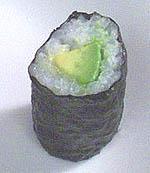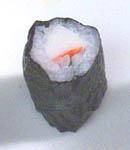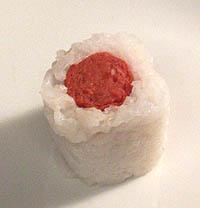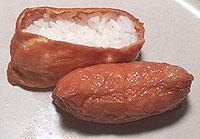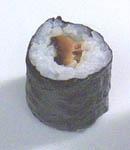 Bento Recipes: Sushi |
|
Let's get one thing out of the way first: sushi does not have to involve raw fish. Certainly mine doesn't. Somehow I don't have that much confidence in the fish I get from my local supermarket, and then after carrying around a bento for hours... Don't get me wrong, I like the raw fish, squid, et cetera sushi. I just don't make 'em. That said, here are the types of sushi I've made for my lunches. Some are very close to regular types, some aren't. All are easy to make, if you can get the hang of rolling it. Here's some help for beginners. Sushi rice: You can either make proper sushi rice, which involves vinegar and stuff, or you can just make regular sticky rice according to the instructions on the package. Choose the approach that suits your taste.
Baby Octopus Sushi: Clean and cook the baby octopi according to the directions on the octopus page. Make some rice blocks, set an octopus on top of each - they shrink during cooking, so you won't need huge blocks like Spam musubi does - and then cut a thin strip of nori to make a "belt" to hold the octopus on the block. A drop of water on the underside of the loose end of the nori will stick it down. Bacon Sushi: Make some rice blocks, either by rolling a log of rice without putting in any fillings or by making it with a rice mold. Then cut slices of bacon (cooked!) the size of the rice blocks and lay 'em on top. If you want, wrap a strip of nori around the whole thing, moistening the underside of the end to stick it down. Note: This takes a little bit of finesse to eat because bacon is tougher than typical sushi ingredients. Breakfast Sushi: Make some sushi rice. Cook two pieces of bacon, making sure they don't get dry and hard. Press the grease off the surface with a paper towel, then chop the bacon into small bits. Lay out the sushi rice so it'll be ready to roll. Break two eggs into a small frying pan and dump in the bacon. Mix well, then scramble the eggs over medium heat. Cook the mixture until it's mostly solid but not yet dry. Take off heat and break up the thicker chunks with the spatula. Then put this in the center of the rice and roll it up. Makes two rolls, 8 pieces each. California Rolls - Cut some artificial crab legs in half the long way to make thinner sticks, and mix these around in a bowl with about 1 tsp of mayonnaise per leg plus a light dash of salt. Cut strips of avocado. Spread a thin layer of rice on a sheet of nori, lay the fillings inside, then roll it up with your bamboo mat, so you end up with a rice-nori spiral around the central fillings. The inside-out variation of this is popular. Chirashi-zushi - This goodie, which is a meal by itself, is complicated and tasty enough to merit its own page. Crab & Cucumber Sushi: Get some fake crab meat - you know, the stuff that's really made with pollack and tastes not much like crab - and some nori. And, of course, cucumber and rice. Spread the rice thinly on the nori, as thinly as you can manage it, covering all but the half-inch closest to you. If you have salmon roe, spread some along the center of the rice where you will lay the fillings. Then put thin strips of peeled cucumber and "crab meat" along the center. You're not likely to have strips long enough to go the whole length, which is fine - just put two or even three end-to-end. Roll it up and press it tightly. Bingo, it's a California roll minus the avocado!
Crab-Topped Sushi - Get some crab meat as used above, and a rice block as used below, and stick the former on the latter. The crab meat I've used in layered in such a way that you can unwrap it so it'll fit neatly over the top of a rice block as opposed to just balancing on top. Cucumber maki - Peel a cucumber, cut the non-seed flesh into strips about 1/4" thick, and roll them up just like avocado maki. Cucumber rolls - These can be made two ways. One involves taking a peeled cucumber and carefully spiral-slicing it with a long, sharp knife so you get a long, thin sheet of cucumber to use as a wrap. I haven't had the patience to try that yet, so I took the easier route and cut a peeled cucumber into 1.5 inch segments, scooped out the inside to make hollow skins, and then put the rice in that. You will have to pack the rice down a tad to keep it from falling out when you pick it up. Anyway, fill the skin most of the way with rice, then put any topping you like on top. I've used salmon roe and shrimp, curled up into little spirals that nestle into the round cucumber skin. Futomaki - This means "big fat roll," and that's basically what it is. Other sushi is designed to be eaten in one bite; futomaki rolls are too large for that. To make one, first get a piece and a half of nori. Moisten the bottom 1.2 inch of the full sheet and stick the half-sheet onto that, so you end up with one very long (legal-sized?) nori sheet. Spread the rice onto that, leaving the bottom 1/2 inch free. Draw an edge of the rice paddle the short way along the rice to score shallow grooves into it. Make a number of these about an inch apart. Then put the fillings along the grooves, one filling per groove. The fillings can be whatever you like; I use cucumber, crab, shiitake mushrooms, omelet, avocado, smoked salmon, et cetera, depending on what I have on hand. Whatever it is, cut it into strips and put it along the grooves. Then roll it up as you would a regular maki roll, being careful not to press the fillings toward yourself. (That's what the grooves are for - to keep the fillings in place as you roll the thing up.) When it's rolled, moisten the inner side of the bit of nori on the bottom that wasn't covered by rice and stick that to the main roll. I usually squeeze futomaki firmly before cutting it up, because it has more of a tendency to fall apart if you don't.
If you have rice paper spring roll wrappers, I recommend using those, as they will keep the rice together, and you won't have to squeeze the grains so hard they lose their rice-y texture.
Inside-out maki - These take a little more skill to make than the usual maki, but only a little. Start out by following the directions as if you were going to make any other kind of maki roll, for example avocado maki, but after you put the rice on the nori turn it upside down, so the nori side is up. (This is easy to do if you're making it on plastic wrap. Just cover it with a second sheet of plastic wrap and flip it over.) Press the nori down with flat, moistened hands to make the rice stick to it. The lay the fillings on the nori and roll it up. You don't want to put too much filling in, however, because you need to have a bit of overlap so the roll will stay together. You can sprinkle this with sesame seeds before you turn the nori-rice sheet over, or even roll the finished maki it in 'em, for an added crunchy texture. Kampyo-Maki - Kampyo is strips of dried gourd, and in the package looks more like heavy twine than something you'd eat. To use the stuff you 1) cut a length of it, however much you plan to use; 2) soak it in water for about 10 minutes; 3) put salt in your hands and crumple the kampyo to rub in the salt; 4) rinse; 5) put the kampyo in boiling water and simmer for 20 minutes until soft; and 6) combine a cup of dashi, 1.5 tablespoons of sugar, 1.5 tablespoons of soy sauce, and 1/2 tablespoons of mirin, and simmer the kampyo for about 30 minutes, until the liquid is nearly gone. (Or you can be lazy and just drain off most of the boiling water and then sling in some soy.) When all that's done you have a ribbon of kampyo, which you can put in the middle of a sushi roll. The kampyo-maki I've seen are narrow rolls, with a diameter about the size of a quarter. Nori-Wrapped Rice Blocks: Either roll a log of rice, just as if you were about to make sushi, but don't add any fillings; or stamp out some rice blocks with a rice mold. Then cut some strips of nori about an inch and a half wide and wrap them around the blocks. If your rice molds are the right shape you can put the nori in them before adding the rice. It's kind of pushing it to call this sushi, but then sushi doesn't have to involve fish. Octopus Barnacle Sushi: Get some baby octopi, the little bitty ones. Cut off the heads and pick out the beaks with the tip of a knife. Heat up a pan to medium and put in a tablespoon of butter. (Or more or less, depending on how many occies you're cooking. You just want to keep them from burning and sticking.) Put one octopus on the pan, colored side upward, tentacles spread. It'll squirm as it cooks. Turn it over after about a minute, when it starts to stand up. (Trust me, you'll see what I mean.) It will turn inside out and stand up as the other side cooks. After half a minute take it off the heat. Now take some sushi rice in your hand and shape a ball about the size of a golf ball. Make a hollow in one side, big enough to fit the base of the curled-up octopus in, and do just that, with the tentacles sticking outward. It will look a little like an open barnacle. Mm-yum, what tasty imagery! Philadelphia Rolls: As is obvious from the name, these are an American invention. They contain smoked salmon, cucumber, and cream cheese, the latter of which gives this roll its name. They're often rolled inside-out, with sesame seeds sprinkled on the outside.
Shiitake Sushi: Make some simmered shiitake mushrooms, then put them on top of rice blocks and belt 'em in with nori. With small mushroom caps one per rice block; if the mushrooms are larger cut them in half. Shrimp Sushi: Get some BIG shrimp. Shell them, leaving the tails on if you want to be fancy. Devein them by slicing shallowly along the back and pulling out the dorsal "line." Then stick bamboo skewers all the way down the shrimp, straightening them out as you go. This will keep them from curling up when you cook them. Bring a small pot of water to a boil and stick the skewered shrimp in for about two minutes to cook them. Take 'em out, let them cool, take out the bamboo skewers, then cut them from the belly upward, cutting almost to but not through the back. Open them up like butterflies and put them on top of blocks of rice. Smoked Salmon Maki: Just like avocado maki, except with smoked salmon strips instead of avocado. Cucumber tastes good with the salmon too. Smoked Salmon Sushi: This one is really tough. Get some smoked salmon. Make some rice blocks, either by rolling a log of rice without putting in any fillings or by making it with a rice mold. Then cut rectangles of smoked salmon about the same size as the rice blocks. Put them on top of the rice blocks. Smoked Salmon Sushi Sandwiches: Get a mold to make rice blocks. Fill the mold halfway, then put in slices of smoked salmon that roughly match the block size and shape. Cover with more rice, press, then shake them out. Wetting the mold before filling it can help keep the rice from sticking, which can be a problem with the way this stuff is split in the middle by the fish. The original recipes I've found actually direct you to make it in a pan, then cut the layer of sushi into pieces, but I'm not into mass production. Smoked Salmon & Kampyo Sushi: Prepare the kampyo as described in the kampyo-maki recipe. Spread rice onto nori as with other sushi rolls, lay smoked salmon along the center, put a strip of kampyo on top of that, and then roll it up. Squid sushi: The squid sushi you get in restaurants is raw, and mine isn't; you can't buy sushi-quality squid just anywhere. Anyway, get a large squid tube (head). Cut rectangular slices about 1"x2" out of the flattest parts. (The more curved parts will curve more when you cook them. Use them in a stir-fry or something else.) Fry them in a bit of vegetable oil on medium heat, turning every minute or two, until they are opaque white. Be careful not to overcook, as squid gets very tough when overcooked. Remove from the pan, allow to cool for a few minutes, pull the rubbery membrane off the inner side, then stick it on top of a rice block and eat. I sometimes put a dab of juice from my bottle of pickled ginger on top of the rice before adding the squid. You may prefer wasabi. Alternately, if you have baby squid you can boil one of those for a few minutes, then put it on top of a rice block and "seatbelt" it in with a strip of nori. This is basically baby octopus sushi, but with squid instead. Tamago Sushi: Get a mold to make rice blocks, or shape bite-sized rice blocks by hand. Then cook some egg and stick it on top, wrapping a narrow belt of nori around the middle if need be to keep it in place. How to cook the egg? You can use a thin sheet, cooked as you would for chirashi-zushi but without cutting into "noodles." You can use the same recipe, but cooked in a thicker sheet. I prefer to use thin slices of rolled omelet because of the pretty spiral pattern. Tuna & Mayo Maki: Open a can of tuna. Drain it well, then mix mayonnaise liberally in. Roll it up in rice according to the avocado maki directions. (Use fake soy-based mayo if you're going to pack this into a nonrefrigerated bento lunch.) Unagi-zushi: basically some unagi no kabayaki over a block of rice. A good way to use up those scraps of leftover eel.
Free-form Maki: Really, anything goes when you're making sushi. Put whatever you like in there! I'll often use whatever I have on hand, including:
Rice Blocks with Toppings: As with nori-wrapped rice blocks, these aren't exactly what you think of as sushi, but sushi doesn't have to involve fish. There's other stuff you can put on sushi-type rice blocks. For example:
|
